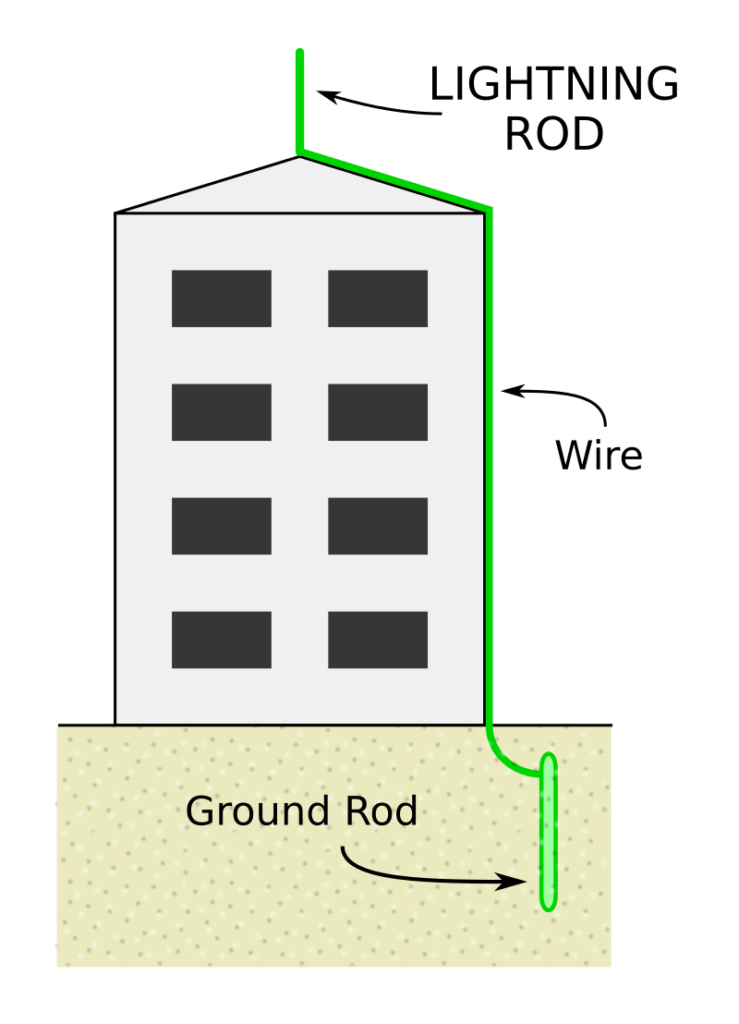
Aluminum is indeed conductive to lightning, but its electrical conductivity is less than that of copper, which is more commonly used for down-conductors in lightning protection systems. In this article, we will explore the question “is aluminium conductive to lightning?
Here are some key points to consider regarding aluminum’s conductivity to lightning:
1. Conductivity: Aluminum has a high conductivity and plasticity, making it suitable for use in lightning protection installations. However, its conductivity is lower than that of copper, which can affect the performance of the lightning protection system.
2. Cost and Weight: Aluminum is lighter and cheaper than copper wire, making it an attractive alternative for lightning protection systems.
3. Corrosion: Aluminum can be used as an air terminal and down-conductor but should not be used as an earth conductor, especially when embedded in concrete due to corrosion problems.
4. Galvanic Couples: Care should be taken when connecting aluminum with other materials, as it can form galvanic couples with steel, which may cause corrosion or other issues.
5. Applications: Aluminum is increasingly used in lightning protection installations due to its conductivity, lightweight, and cost-effective properties.
6. Safety: Although aluminum is not as conductive to lightning as copper, it can still provide reliable protection against lightning strikes. Lightning cannot be prevented, but using aluminum in lightning protection systems can help minimize the damaging effects of lightning charges on buildings and other structures.
In conclusion, aluminum is conductive to lightning, but its conductivity is lower than that of copper. Aluminum is lighter, cheaper, and more corrosion-resistant than copper, making it an attractive alternative for lightning protection installations.
However, care must be taken when connecting aluminum with other materials to avoid potential issues such as galvanic couples and corrosion.
- What role does the surface condition of aluminum play in its ability to conduct lightning?
- Can you explain the mechanisms in “is aluminium conductive to lightning?
- Are there instances where the conductivity of aluminum is not sufficient for lightning protection?
- What is the recommended diameter for aluminum conductors in lightning protection systems?
- What is the maximum length of aluminum conductors in lightning protection systems?
- Are there any safety concerns when using aluminum conductors in lightning protection systems?
- Helpful Resources
What role does the surface condition of aluminum play in its ability to conduct lightning?
The surface condition of aluminum plays a significant role in its ability to conduct lightning. Here are some key points to consider:
1. Conductivity: Aluminum has a high electrical conductivity, making it suitable for use in lightning protection installations. Its conductivity is of the same order of magnitude as copper’s, making it an attractive alternative for lightning protection systems.
2. Corrosion: The surface condition of aluminum is crucial in maintaining its conductivity. Corrosion can significantly impact the conductivity of aluminum, affecting its ability to effectively conduct lightning strikes.
3. Alloys and Coatings: Some aluminum alloys, particularly those with magnesium and silicon, result in conductors that are easy to handle and have good mechanical strength, making them suitable for lightning protection installations. Additionally, coatings or treatments can be applied to aluminum surfaces to enhance their resistance to corrosion and maintain their conductivity.
4. Visibility: As the conductivity of aluminum is less than copper, cables made of aluminum are larger and therefore more visible. This issue has the advantages of using aluminum in lightning protection systems.
Proper maintenance, corrosion resistance, and the use of suitable alloys and coatings are essential to ensure that aluminum maintains its high electrical conductivity and effectively conducts lightning strikes in lightning protection systems.
Can you explain the mechanisms in “is aluminium conductive to lightning?
Aluminum dissipates the energy from a lightning strike through several mechanisms, which help to protect structures and people from the damaging effects of lightning strikes:
1. Path of Ionization: When a lightning strike occurs, a path of ionization begins from the cloud and extends earthward, establishing the route for the electrical discharge.
Aluminum, being a highly conductive material, can help dissipate the energy along this path, reducing the risk of damage to structures and reducing the risk of fire and explosion.
2. Current Discharge: During a lightning strike, the electrical current discharges through the aluminum, creating a low-resistance path to the ground. This helps to minimize the voltage gradient in the structure, reducing the risk of damage and fire.
3. Heat Dissipation: The electrical currents generated by a lightning strike can cause hot spots on the aluminum surface, which can then radiate heat into the surrounding environment. This process helps to dissipate the energy and prevent the formation of electrical arcs, which could cause damage or start a fire.
4. Corrosion Resistance: Aluminum is resistant to corrosion, making it a suitable material for use in lightning protection systems. This resistance to corrosion ensures that the aluminum maintains its conductivity and effectively dissipates the energy from lightning strikes.
5. Grounding: Proper grounding of aluminum lightning protection components is crucial for dissipating the energy from lightning strikes. Grounding systems help to distribute the electrical charge evenly across the surface of the structure, reducing the risk of damage and fire.
In conclusion, aluminum dissipates the energy from a lightning strike through mechanisms such as the path of ionization, current discharge, heat dissipation, corrosion resistance, and grounding.
These mechanisms help to protect structures and people from the damaging effects of lightning strikes.
Are there instances where the conductivity of aluminum is not sufficient for lightning protection?
The conductivity of aluminum is generally sufficient for lightning protection, but there are some considerations to keep in mind:
1. Visibility and Size: Due to its lower conductivity compared to copper, cables made of aluminum are larger and therefore more visible. This can be advantageous for lightning protection systems, as the visibility of the system components can serve as a deterrent to lightning strikes.
2. Corrosion Resistance: Aluminum is resistant to corrosion, making it a suitable material for use in lightning protection systems. However, care should be taken to avoid galvanic corrosion when connecting aluminum with other materials, such as steel or zinc-plated surfaces.
3. Material Selection: Lightning protection components are made from materials that are resistant to corrosion and must be protected from accelerated deterioration. Copper, copper alloys, and aluminum are the basic system component materials, and they serve the best combination of function for current carrying and weathering.
4. Conductor Design: Lightning protection system conductors, whether made of copper or aluminum, are designed to maximize surface area to carry lightning and provide flexibility for installation practices.
The construction of the conductors allows for easier bending and forming of the conductor system along, around, and over building construction elements.
In conclusion, while the conductivity of aluminum is generally sufficient for lightning protection, there are considerations related to visibility, corrosion resistance, material selection, and conductor design that should be taken into account when using aluminum in lightning protection systems.
These considerations ensure that aluminum effectively dissipates the energy from lightning strikes and provides reliable protection for structures and occupants.
What is the recommended diameter for aluminum conductors in lightning protection systems?
The recommended diameter for aluminum conductors in lightning protection systems is typically 5/8″ for braided cable consisting of 26 strands of 14 gauge aluminum wire.
This diameter and configuration provide the necessary conductivity and mechanical strength to effectively conduct lightning safely. The larger size of aluminum conductors compared to copper is advantageous for visibility, which can serve as a deterrent to lightning strikes.
Additionally, aluminum conductors are designed to maximize surface area to carry lightning and provide flexibility for installation practices, ensuring their effectiveness in lightning protection systems.
What is the maximum length of aluminum conductors in lightning protection systems?
The maximum length of aluminum conductors in lightning protection systems is not explicitly specified in the search results. However, there are some general guidelines and considerations to follow when installing lightning protection systems:
1. Conductor Sizes: Aluminum conductors for lightning protection systems are typically 5/8″ in diameter, consisting of 26 strands of 14-gauge aluminum wire.
2. Conductor Rise: The conductor should not rise more than 3 inches per 12 feet of run.
3. Bend Radius: The bend radius of the conductor should not be less than 8 inches, and the conductor should not form a sharper angle than 90 degrees.
4. Grounding: Grounding systems should be designed and installed in accordance with the requirements of nationally recognized safety standards, such as NFPA 780, LPI 175, and UL96A.
5. System Design: A complete lightning protection system should include multiple pathways of adequate size and conductivity, such as a rooftop network to capture the strike and a grounding network to dissipate the charge into the ground.
While the maximum length of aluminum conductors in lightning protection systems is not specified, following these guidelines and considerations can help ensure the effectiveness and safety of the system.
Are there any safety concerns when using aluminum conductors in lightning protection systems?
When using aluminum conductors in lightning protection systems, there are several safety concerns and considerations to keep in mind:
1. Corrosion: Aluminum conductors should not be used as earth conductors or embedded in concrete due to corrosion problems. Corrosion can significantly impact the conductivity of aluminum, affecting its ability to effectively conduct lightning strikes.
2. Compatibility: Aluminum conductors must be used on aluminum, steel, or zinc-plated surfaces to avoid galvanic corrosion, and must not be used in contact with other materials that form electrolytic couples in the presence of moisture.
3. Material Selection: Lightning protection components are made from materials that are resistant to corrosion and must be protected from accelerated deterioration. Many system components will be exposed to the atmosphere and climate, and combinations of materials that form electrolytic couples in the presence of moisture shall not be used.
4. Conductor Design: Since aluminum materials have slightly lower current carrying capability and mechanical strength than similar sized copper products, listed and labeled materials for lightning protection include larger physical size parts. Materials suitable for use in lightning protection systems are listed, labeled, and tested according to UL Standard 96.
5. Installation Practices: Care should be taken when connecting aluminum with other materials to prevent galvanic couples, and the design and installation of lightning protection systems must comply with the requirements of nationally recognized safety standards such as NFPA 780, LPI 175, and UL96A.
In conclusion, when using aluminum conductors in lightning protection systems, it is important to consider corrosion resistance, compatibility with other materials, material selection, conductor design, and installation practices to ensure the safety and effectiveness of the system.
Helpful Resources
- https://at3w.com/en/blog/aluminium-emerges-as-a-highly-advantageous-material-for-lightning-protection-installations/
- https://www.sciencedirect.com/science/article/pii/S1350630715300613
- https://www.nassauelectrical.com/products/aluminum-lightning-protection-cable
- https://www.metalconstructionnews.com/articles/metal-roofing-and-lightning/
- https://www.sciencedirect.com/science/article/pii/S1000936120304040
- https://ecle.biz/lightning-protection/system-elements/
- https://lightning.org/lightning-protection-overview/
- https://www.electriciantalk.com/threads/lightning-current-and-wire-size.293607/
- https://wblightningrods.com/lightning-protection-materials/
- https://esgrounding.com/blog/what-are-the-lightning-protection-standards-for-lightning-down-conductor-installation
- https://kuefler-lightning.com/general-notes/
- https://thecorrecter.com/is-aluminium-in-deodorant-harmful/
- https://thecorrecter.com/is-aluminium-metal-or-non-metal/
- https://thecorrecter.com/can-you-weld-aluminium-with-a-stick-welder/
- https://thecorrecter.com/how-to-weld-aluminium-with-a-mig-welder/
- https://thecorrecter.com/how-to-solder-aluminium-with-a-soldering-iron-3-best-steps/
- https://thecorrecter.com/is-forged-aluminium-cookware-safe/
